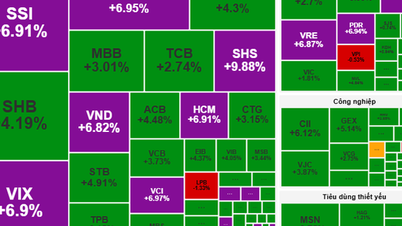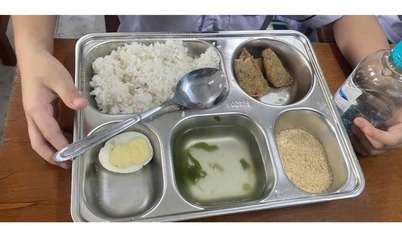According to current regulations, business individuals with annual revenue of over 100 million VND must pay personal income tax (PIT) at a direct rate on revenue. Revenue is calculated as the total amount of sales, processing, commissions, and service provision arising during the tax period. In case the revenue cannot be determined, the tax authority will apply the determination measures according to regulations.
Tax for individuals doing business is calculated like a business.
However, from January 1, 2026, when the policy of abolishing the lump-sum tax form was implemented, the Ministry of Finance added to the draft Law on Personal Income Tax (amended) a new tax calculation method based on income instead of revenue. Accordingly, business individuals with revenue exceeding the threshold prescribed by the Government will have to pay tax by multiplying taxable income by the tax rate of 17%.
Taxable income is understood as revenue from the sale of goods and services after deducting expenses related to production and business activities during the period. This calculation is similar to the provisions of the Law on Corporate Income Tax (CIT), which currently applies a rate of 17% for small and medium-sized enterprises with revenue from 3 billion to 15 billion VND per year.
For business individuals with revenue below the tax threshold, the current method of calculating tax based on revenue ratio is still maintained.
The new draft on personal income tax of the Ministry of Finance also stipulates the tax rate calculated on the revenue of individuals doing business in each field. Specifically, the distribution of goods remains at 0.5%; services, construction without contracted materials reduced from 2% to 1.5%; production, transportation, construction with contracted materials reduced from 1.5% to 1%; property leasing, insurance agency, lottery, multi-level marketing reduced from 5% to 3%; digital content services such as games, movies, music, advertising reduced from 5% to 3%. Other business activities remain at 1%.
Mr. Nguyen Van, a technology car driver in Ho Chi Minh City, said that all of his revenue is paid through banks and apps, so when he reaches over 100 million VND/year, he has to pay tax at a rate of 1.5% of total revenue.
According to him, the current calculation has created a lot of pressure because the net income is only about 8.3 million VND/month, while having to pay for gas and car maintenance costs. "If we have to pay 17% tax in the future without family deductions or expense deductions, it will be too high. I hope that the starting point for tax should be raised from 200 million VND/year so that we have more motivation to work harder" - he wondered.
Ms. Thuy Linh (living in Gia Lai province), who does agricultural business, also shared her own difficulties. According to her, profit margins in the agricultural industry are often very low, below 5%, so applying the method of calculating tax based on revenue is unreasonable. If calculated based on profit, it is stuck in proving input costs, because agricultural production in Vietnam is still mainly small-scale, and businesses often purchase through traders and agents. "If applying new regulations, the State needs to have specific and detailed instructions for businesses to easily implement, avoiding confusion or disadvantages" - Ms. Linh expressed.

According to the new proposal of the Ministry of Finance, individual businesses can be taxed at 17% after deducting expenses. Photo: Hoang Trieu
Difficult to determine costs
Mr. Nguyen Ngoc Tinh, Vice President of the Ho Chi Minh City Tax Consultants and Agents Association, assessed that the tax calculation for business individuals with revenue of over VND3 billion by the method of revenue minus expenses multiplied by the tax rate of 17% has a positive point in that it is based on profit instead of total revenue as before. However, Mr. Tinh also pointed out many challenges, especially the confusion between the concepts of business individuals and business households. In reality, many business households have the nature of business activities of business individuals, leading to unclear policy application.
Mr. Tinh gave an example: people who provide car transportation services in a conditional industry are required to register as business households and pay lump-sum tax or tax on revenue. However, if they only rent cars for customers to drive themselves, individuals do not need to register as business households because they are not in the conditional business category. This difference can easily cause controversy in determining taxable subjects.
Another problem is the difficulty in proving valid expenses for deduction. Most individuals and businesses do not have complete invoices and documents, so determining expenses is almost impossible. Therefore, Mr. Tinh warned that if a 17% tax rate is applied to revenue without allowing expenses to be deducted, it will become a big burden and cause damage to taxpayers.
According to him, the Ministry of Finance needs to clarify the legal boundary between business households and individual businesses, and at the same time develop a tax calculation method suitable for each field. Tax policy, according to Mr. Tinh, must accurately reflect actual profits to ensure fairness and feasibility when applied.
Sharing the same view, lawyer Nguyen Duc Nghia, Deputy Director of the Center for Supporting Small and Medium Enterprises (Ho Chi Minh City Business Association - HUBA), also emphasized the unreasonableness of applying a 17% tax rate to business individuals while the Law on Corporate Income Tax 2025 (effective from October 1) only stipulates a 15% tax rate for small and medium enterprises with revenue under VND3 billion. Therefore, Mr. Nghia recommended applying a 15% tax rate instead of 17% for business individuals with revenue over VND3 billion, to create fairness between business types and in line with the general policy of the Government .
In addition, lawyer Nghia also pointed out the shortcomings of the new draft, which is that it has not reduced taxes for many important industries such as distribution, supply of goods, services, construction, production, and transportation. In addition, the 5% rate applied to property leasing, insurance agents, lottery, multi-level marketing, and digital services is considered too high. Therefore, he proposed keeping the tax at 0.5% for goods distribution; reducing taxes on services and non-contracted construction from 2% to 1.5%; production and transportation from 1.5% to 1%; and digital and multi-level services to about 3%.
Proposal to increase family deduction to 15.5 million VND/month
The Ministry of Finance has just sent the Ministry of Justice a draft Resolution of the National Assembly Standing Committee on adjusting the personal income tax family deduction level. Accordingly, this agency proposed to increase the family deduction level for taxpayers from 11 million VND/month to 15.5 million VND and for dependents from 4.4 million to 6.2 million VND (an increase of about 40.9%).
With the above proposed plan, people with salary and wage income of 15 million VND/month do not have to pay personal income tax after deducting social insurance, health insurance, and unemployment insurance. If the income is 20 million VND, the tax payable is about 120,000 VND/month after deducting insurance costs.
In case of having one dependent, an individual with income of 25 million VND will pay tax of 33,750 VND; with income of 35 million VND, the tax rate is 265,000 VND.
In case there are allowances, subsidies, and voluntary retirement insurance participation deducted before calculating tax, the tax payable will be lower or zero.
When applying this proposed reduction, most taxpayers in tier 1 will move to zero tax (accounting for 95% of current tier 1 taxpayers). Along with that, a portion of individuals in tier 2 will move to tier 1 or zero tax. Similarly, those in the remaining tax tiers will all have their personal income tax payable reduced.
Mr. Chien
Source: https://nld.com.vn/thue-cho-ca-nhan-kinh-doanh-con-nhieu-van-de-19625090921260473.htm



![[Photo] Prime Minister Pham Minh Chinh chairs a meeting of the Government Standing Committee to remove obstacles for projects.](https://vphoto.vietnam.vn/thumb/1200x675/vietnam/resource/IMAGE/2025/10/06/1759768638313_dsc-9023-jpg.webp)
![[Photo] Prime Minister Pham Minh Chinh chaired a meeting of the Steering Committee on the arrangement of public service units under ministries, branches and localities.](https://vphoto.vietnam.vn/thumb/1200x675/vietnam/resource/IMAGE/2025/10/06/1759767137532_dsc-8743-jpg.webp)
































































































Comment (0)